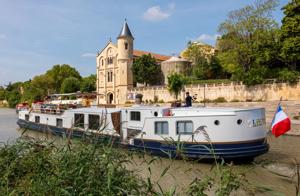
The sun shone on a chilly spring day when I pulled up to the Elegance, a new, art deco-inspired barge and my home for this week in southern France. My journey started in the quaint town of Sallèles-d’Aude, adjacent to the , a waterway recognized as a UNESCO World Heritage site. Our “floating hotel” would take us along this canal — an engineering feat when it was built between 1667 and 1694 — to vineyard-dotted landscapes, medieval towns and other historic sights, all waiting to be explored.
As we entered the first lock, the back door shut and water started filling the space, raising our barge about six feet or so, until we could exit from the front door. Once we passed, the lock closed and the water drained, waiting for the next boat. We passed through five locks before we reached our first stop, .

Le Somail, an iconic village on the Canal du Midi, noted for its 300-year-old buildings. Minervois vineyards surround the charming 17th-century hamlet, and just over the cobblestone bridge, an original ice house from 1864 stands. I followed the dirt path to Le Trouve-Tout du Livre, a second-hand bookshop housed in a former wine cellar and bursting at the seams with more than 50,000 books.
Across the path, a floating épicerie awaited travellers who needed supplies or, like me, wanted one more pain au chocolat. Back on board, we continued toward , a UNESCO-listed medieval walled fortress, complete with a castle, double ramparts and 52 towers. Cruising the canal, the vineyards of the Languedoc region peeked out over the rolling hills.
Our barge’s captain, Mathias Gilles, who grew up in this area, described the Crusades’ path through here as we disembarked. On this day, street performers entertained the crowds inside the walls of Carcassonne, and specialty shops bustled with activity. Fresh from a peaceful night’s sleep on the barge, we headed onwards to , a small rural village that’s among the country’s most beautiful (it belongs to an association called Les Plus Beaux Villages de France).
Original catapults jut out from the mountainside, while old stone buildings now house pretty cafés and artisan boutiques. After restocking wine and cheese for the barge at a small shop, we cruised to , the town known for French playwright Molière’s performances in the 17th century. Unspoiled by modern development, the labyrinthine passageways lead to the town centre, which is protected as a historic monument.
Shops and studios now occupy the 17th-century buildings, like the one I visited where a sixth-generation weaver worked his loom, surrounded by pieces made by his mother and grandmother. I secured berlingots — the area’s iconic candy — and returned to the barge, where I relaxed on the upper deck, lulled by soft breezes and fairy-tale towns drifting by. Onboard the Elegance, a “floating hotel” that cruises along the historic Canal du Midi.
Our final excursion, , emerged across the field with its cathedral beaconing from high above. The city features elegant 19th-century Haussmannian buildings lining wide streets, which branch into narrow cobblestone alleyways filled with clothing boutiques, soap shops and bawdy bars. Tucked in a corner outside the Cathédrale Saint-Nazaire, a statue of a bound Joan of Arc stands, alongside her response to the judges etched in stone.
It is a powerful monument to France’s patron saint. For our final night aboard the Elegance, we moored at . Eight oval-shaped locks and nine sets of gates create a staircase to cross the river Orb, 48 metres lower than the canal.
In 1858, an aqueduct replaced the system, but the engineering marvel still stands, a fitting end to our voyage..














